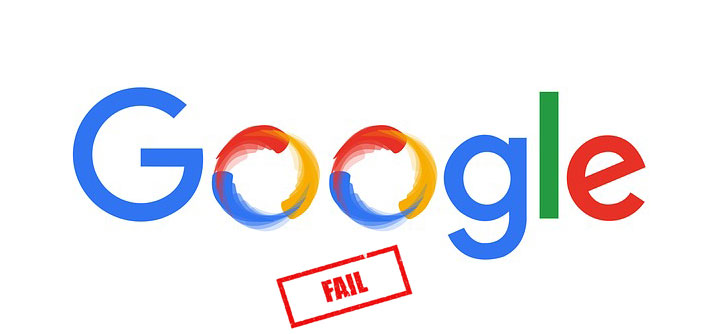Although Google is the mighty corporation that is not only conquering cyberspace but also our planet in its entirety, even they have managed to commit several unpleasant mistakes. Below is a list of Google failures that will take a closure look at some of the most notable failures of the corporate giant.
Here is list of Google Failures
#1 Google Banning its Resource
Back in March 2001, Google decided to acquire an online service that was designed to compare prices. The service was called Beat That Quote and Google made that purchase for 37.7 million pounds. A mere day later, the website was banned by Google itself for “violation of recommendations from webmasters’ guide”.
Soon after purchasing the website, its aggressive SEO policy was identified. The resource was buying links, using doorways along with other shady methods of generating traffic. Consequently, Google punished Beat That Quote. A website is still being indexed, but it does not appear on top of search issuance’s results anymore.
#2 Being Suspected in Purchasing Links
In February 2016 Google paid about 350 000 dollars for a logo with a Chrome link in it to appear on Let’s Encrypt – certification centre’s online resource. The logo had to be placed in the “Sponsorship” section. Google is actively promoting encryption, and the certification centre is issuing free TLS certificates for it whenever it is necessary.
Google’s main objective, in this case, was probably related to sponsorship support. Nevertheless, the no follow attribute closed that link only after some time, whereas Google itself dictates very harsh rules and requirements for the search. And, of course, we all know about its attitude towards purchased links.
#3 Purchasing Links with Hidden Anchors
In April 2011 Google was suspected of acquiring links on a popular European blogging conference website – Re: public. Google was acting as its sponsor.
The links did not feature the no follow attribute, and this fact does violate Google’s webmasters’ rules. Furthermore, the source code itself indicated that the link featured a hidden anchor-text.
Consequently, numerous users blamed Google for double standards when the corporation itself is allowed to break its rules regarding online marketing and fair promotion.
#4 Using Cloaking
Back in March 2005, Google was first accused of resorting to cloaking. This was the first time when Google had to take action against itself.
One of the company’s employees posted hidden content that was designed for internal users of Google search engine. However, the changes were identified and indexed by the main search system, and it attributed them to breaking the web-masters’ regulations. After the incident had been noticed and discussed by the general public, web pages were deleted from search results. A similar episode occurred in 2010, but it was then related to banning the AdWords Help pages.
#5 Google Japan and Purchased Links
In February 2009 Google’s Japanese division admitted that it was purchasing links to promote a Google widget. Following this confession, Google’s spam search team lowered Google Japan rating from 9 to 5. The PageRank indicator is one of many factors that impact the position of a certain website within the search issuance’s results. As for today, Google no longer displays the PageRank indicator.
#6 Purchasing Links via Apache.com
This incident occurred quite recently – during autumn 2016.
Apache is one of the largest software suppliers on the market, and its website features a page with thanks to the sponsors. The sponsors are divided into platinum, gold, silver and bronze categories. Google appears within the first category. Keep in mind that to be mentioned in the list of platinum sponsors, it is necessary to contribute 100 000 dollars on a yearly basis.
Should you take a closer look at the bronze sponsors’ web page and its source code, you will notice the lack of the no follow attribute. Google itself should deem those links as purchased ones. Subsequently, it turns out that Google allowed posting a web link for itself on a website with purchased links.
#7 The Thumbtack Scandal
In 2014 Thumbtack – a website that specialises in searching for professionals, which was being backed up by Google Capital, was manually filtered for unnatural links that were supposedly leading towards the website. According to Johnathan Swanson, company’s CEO, they were banned for a post that he called “erroneous”. The post was allowing the users to get 30 additional points for posting Thumbtack link on their websites.
The resource denied any allegations and claimed that they were never purchasing any links and are not planning to acquire them in the future.
Thumbtack is not the first company that was sponsored by Google and consequently sanctioned in such a way. The overall Google’s investments into the project reach 100 million dollars. However, all filters are disabled on the Thumbtack website today.
#8 Promoting Google Chrome
Back in 2008 Google launched a new version of its online browser – it was called Google Chrome. Many users rightfully considered its marketing campaign to be far too aggressive and even contradictory when it comes to the web-masters’ rules.
Posts that would end with a “sponsored by Google” phrase were particularly resonant. After all, the link for the browser was direct and, consequently, not closed by the no follow attribute, so it should be sanctioned by Google in the same way that any purchased links would be.
While the above-mentioned failures could be contributed to Google’s online actions, the list will be concluded with a more tangible failure that took place in the real world.
#9 The Google Glass Development- Biggest Google Failure
The Google Glass concept resembled a sci-fi dream come true; it was a very good idea that turned into an epic failure. There are several reasons why it happened:
- Health and safety
Even before the glasses were ever released to the public, many people were quite sceptical towards wearing such a device that could, allegedly, be emitting harmful radiation, on their heads. Besides, quite a few users considered that the gadget would be harmful to their eyes.
As for the safety issues – thanks to the possibility of recording videos with a snap of one’s fingers, Google Glass is banned in casinos and cinemas, and many consider that wearing them infringes the basic human rights, to begin with. At least when it comes to inviolability of one’s private life.
- Unpleasant design
Although the concept of installing a smart-device into a pair of glasses sounded awesome at first, in truth the Google Glass design turned out to be very clumsy, to say the least. Perhaps the main reason here lies within the fact that the product is still in development.
- Unclear purpose
The purpose of any product lies within searching a problem that it could resolve or perhaps a wish that it could satisfy. It is very important not to try and apply something you came up with first on the market that does not ask for it.
Google Glass has several main objectives – the possibility of quickly making a photo or a video and getting information from the internet. Any modern smartphone could do that just as easily, and users are much more accustomed to these devices.
- Google Glass Explorers
The first version of Google Glass was not available in stores and was instead given to the so-called Glass Explorers – a group of “explorers” in 2013. It would cost $1500 and was released for general public in 2014 for the same price. Most of the “explorers” were journalists and tech enthusiasts who were unable to find any serious advantages of the Google Glass technology.
Final words on Google Failures
This article’s purpose was not to try and demise Google’s achievements. After all, Google is pretty much the synonym of Internet these days – we are more used to saying “Google it” than asking a person to go on the net to search for something. We wanted to demonstrate that even such a titan of the industry may still commit mistakes. Nevertheless, we love Google for everything it has done for us. Can’t you say the same?






Leave a Reply